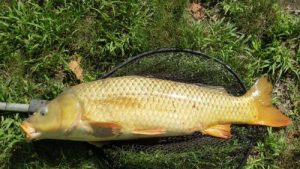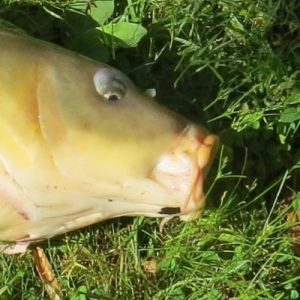
The common carp is found across North America, Europe and other parts of the world. Carp are popular among freshwater anglers and can be caught using a variety of techniques.
Common carp are omnivorous; they eat aquatic vegetation, insects, crustaceans, worms, fish eggs, fallen fruit, and other food sources.
A variety of baits are used to catch common carp. Some anglers use more than one type of bait, while others feel there is a single best bait for catching carp.
When choosing bait for catching carp, it is important to decide whether to fish for a variety of species, or if carp will be targeted exclusively. Some baits will attract a variety of species, while others tend to be ignored by most species, yet still catch carp.
For anglers that want to catch more than one species, Nightcrawlers or earthworms are usually one of the top baits. In addition to catching carp, worms often attract catfish, sunfish, perch, trout, and other fish.
When other species of fish are a nuisance, carp specialists often choose corn, doughballs, cheese, salmon eggs, or prepared baits.
Baits for catching carp include:
- nightcrawlers
- earthworms
- insect larvae (grubs)
- corn
- dough balls
- bread
- cheese
- synthetic “scented” baits
- salmon eggs
- chicken livers
- shrimp
- crawfish
- crickets
- grasshoppers
Most carp anglers are careful to rig baits so that they are presented on or near the bottom. Method rigs, top and bottom rigs, bobber-hook rigs, and Carolina bait rigs are among the most common presentations. For carp fishing, anglers choose a variety of hook configurations, including live bait, treble, or other hooks.
When fishing with prepared bait-balls, some anglers use specialized rigs that affix the bait to the line. Hair rigs contain a short section of line from the hook that is threaded through baits. With these rigs, the carp is allowed to swallow the bait and the hook is pulled in the fish’s mouth.

Carp are highly sensitive feeders and special techniques are sometimes required when bait fishing. Many anglers leave their fishing reels open or out of gear which allows carp to take the bait and move away without detecting the fishing line.
Occasionally, carp are caught using artificial lures. They are sometimes caught using soft plastic grubs, worms or other imitations. Scented soft lure bodies are popular as they seem to catch larger numbers of fish that feed by smell.
One of the more unusual methods for catching carp involves mimicking natural food sources. In some areas, carp are known to gather when mulberries ripen and begin falling into the water from overhanging trees. During these conditions, anglers use fresh mulberries as bait or cast purple colored ‘mulberry flies’.
What Do Invasive Carp Eat?
The term “invasive carp” refers to four carp species – black carp, grass carp, bighead carp, and silver carp. Bighead and silver carp eat plankton, competing with native fish and mussels. Grass carp consume plants and can drastically change river and shoreline vegetation. Black carp eat mainly snails and mussels.